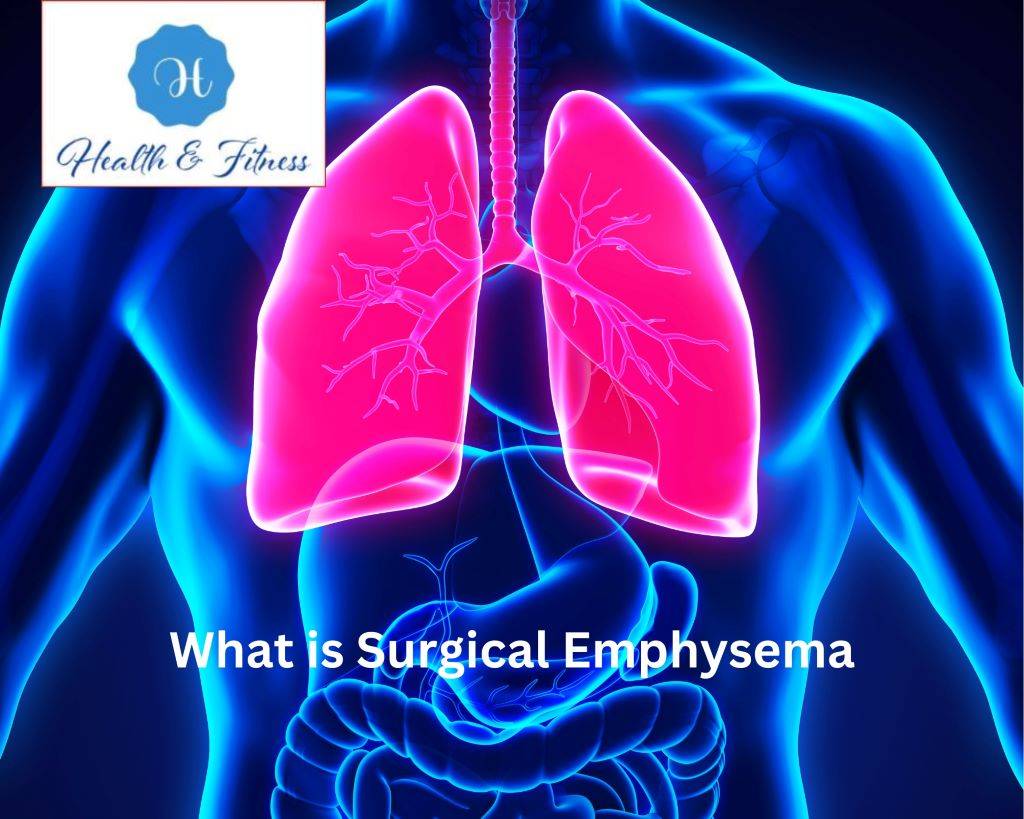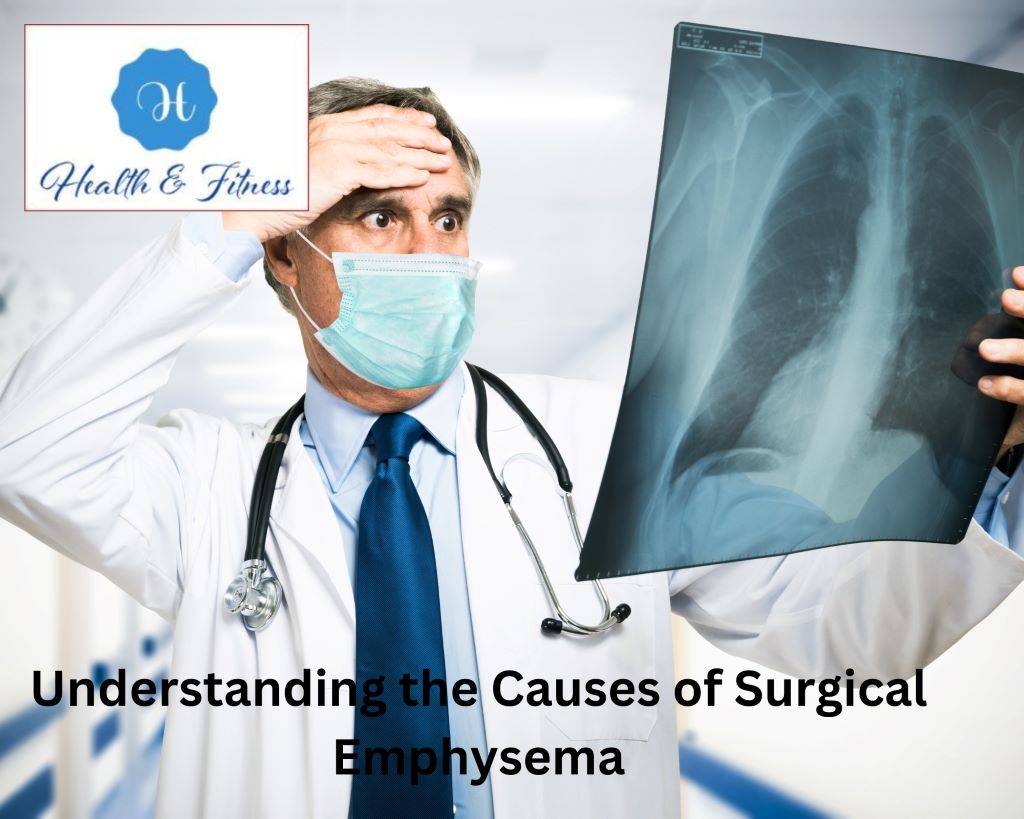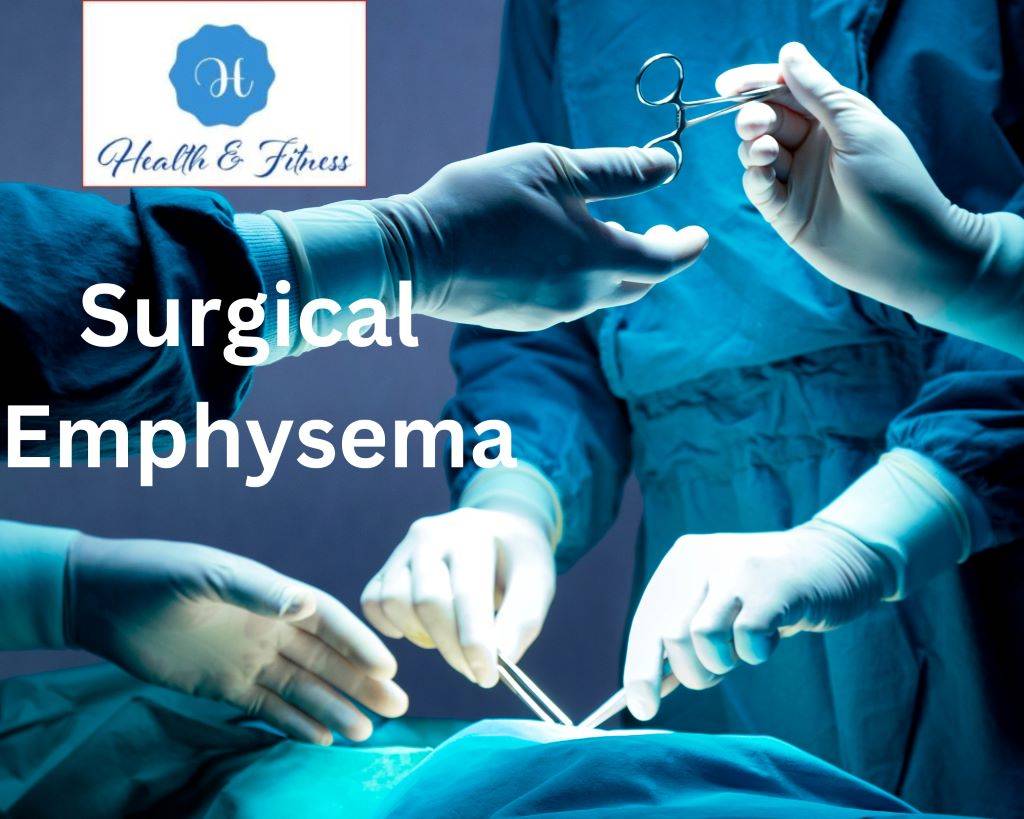Surgical emphysema is a condition that can occur during medical procedures, causing discomfort or serious complications. Understanding its risks, complications, and prevention is crucial for safe medical practices. This blog post will explore surgical emphysema, its symptoms, treatment, and coping strategies.
What is Surgical Emphysema?

Air trapped in the chest, neck, or face causes emphysematous edema. Air may accidentally enter tissues during medical operations via a tiny rip or hole. When air becomes trapped in the soft tissues, it can create pockets or bubbles under the skin, causing swelling, pain, and discomfort. In more severe cases, surgical emphysema can also cause difficulty breathing or swallowing and even be life-threatening. Subcutaneous emphysema is typically diagnosed through a physical examination, which may include palpation of the affected area to detect air pockets. Imaging tests, such as X-rays or CT scans, may also confirm the diagnosis and assess the extent of the condition.
While surgical emphysema can be a severe condition, it is usually treatable with appropriate medical intervention. In the next section, we’ll inspect the causes of surgical emphysema and the factors that can increase the risk of developing this condition.
Understanding the Causes of Surgical Emphysema

Subcutaneous emphysema may develop during medical operations, especially those that puncture or manipulate soft tissues. Surgical emphysema’s leading causes are:
- Injury to the airway or lung tissue: During specific medical procedures, such as intubation or lung biopsies, there is a risk of accidentally puncturing the airway or lung tissue. This can cause air to leak out of the lungs and into the surrounding soft tissues, leading to Mediastinal emphysema.
- Pneumothorax: Pneumothorax is a condition in which air leaks into the space between the lung and the chest wall, causing the lung to collapse. This can occur as a complication of specific medical procedures, such as chest tube placement or mechanical ventilation, and can lead to surgical emphysema.
- Dental procedures: Dental procedures involving air-driven instruments, such as dental drills or air syringes, can also lead to surgical emphysema if the air is accidentally introduced into the soft tissues of the face or neck.
- Cosmetic procedures: Certain cosmetic procedures, such as facelifts or liposuction, can also increase the risk of developing surgical emphysema if air is inadvertently introduced into the soft tissues.
Obesity, smoking, advanced age, and medical problems like emphysema or COPD raise the risk of surgical emphysema.
Surgical emphysema is uncommon yet dangerous. It is usually minor and resolves without treatment. In severe situations, therapy may alleviate symptoms and prevent problems. Surgical emphysema symptoms are the following.
Common Symptoms of Surgical Emphysema

Surgical emphysema can cause various symptoms, varying depending on the location and extent of the air pockets in the body’s soft tissues. Some of the most common symptoms of surgical emphysema include:
- Swelling: Swelling is one of the most common symptoms of surgical emphysema. It occurs when air pockets form in the soft tissues, creating a bubble-like appearance under the skin. Swelling can be mild or severe, accompanied by pain or discomfort.
- Pain or discomfort: Surgical emphysema can cause pain or discomfort in the affected area, mainly if the air pockets are large or near sensitive nerve endings.
- Difficulty breathing: In more severe cases, surgical emphysema can cause difficulty breathing or shortness of breath, mainly if the air pockets are near the airway or lungs.
- Difficulty swallowing: Surgical emphysema can also cause difficulty swallowing if the air pockets are in the neck or throat.
- Crunching or popping sounds: When air pockets form in the soft tissues, they can create a distinctive crunching or popping sound when the affected area is touched or moved.
It’s important to note that not all cases of surgical emphysema cause symptoms, and some patients may resolve independently without medical intervention. However, if you experience any of the symptoms listed above after a medical procedure, seeking medical attention right away is essential to rule out any serious complications.
In the next section, we’ll inspect the treatment options available for surgical emphysema.
Treatment Options for Emphysema

In most cases, Soft tissue emphysema is a self-limiting condition that resolves independently within a few days or weeks. However, treatment may be necessary in more severe cases to relieve symptoms and prevent complications.
Some of the most common treatment options include:
- Observation: In mild cases of Subcutaneous emphysema, your doctor may recommend comment to monitor the condition and ensure it resolves independently. This may involve regular check-ups to monitor your symptoms and progress.
- Oxygen therapy: In cases where surgical emphysema is causing difficulty breathing or other respiratory symptoms, oxygen therapy may be recommended to help improve oxygenation and relieve symptoms.
- Antibiotics: In rare cases, a bacterial infection may cause surgical emphysema. In these cases, they may prescribe antibiotics to help treat the underlying disease and prevent complications.
- Surgery: In sporadic cases, surgery may be necessary to drain the air pockets or repair any underlying tissue damage that may contribute to the condition.
Subcutaneous emphysema is usually harmless and disappears without treatment. However, if you develop Mediastinal emphysema following a treatment, get medical assistance immediately to rule out significant consequences.
At the article’s conclusion, we’ll discuss Mediastinal emphysema prevention and post-op problems.
Risks and Complications Associated with Surgical Emphysema Treatment
It is benign and self-resolving, although treatment may be risky. Common hazards of Surgical site emphysema therapy include:
- Infection: Any medical procedure carries a risk of disease, and treatment for surgical site emphysema is no exception. In rare cases, treatment for Mediastinal emphysema may cause an infection at the site of the procedure.
- Bleeding: Treatment for Soft tissue emphysema may involve puncturing the skin or soft tissues to drain the air pockets. In rare cases, this can cause bleeding or other complications.
- Nerve damage: The nerves that run through the body’s soft tissues can be susceptible, and treatment for Tissue emphysema may pose a risk of nerve damage.
- Scarring: Treatment for Soft tissue emphysema may cause scarring or other cosmetic changes to the affected area.
- Recurrence: In some cases, Tissue emphysema may recur even after treatment. This may require further medical intervention to resolve the condition.
Discuss surgical emphysema issues with your doctor before surgery.
Your doctor can help you weigh treatment pros and cons.
Last, we’ll examine tissue emphysema prevention and post-op issues.
How to Prevent Surgical Emphysema During Medical Procedures
While Mediastinal emphysema is a rare and benign condition, there are steps you can take to reduce your risk of developing it during medical procedures. Here are some tips to keep in mind:
- Follow pre-procedure instructions: Before any medical procedure, your healthcare provider will provide detailed preparation instructions. Be sure to follow these instructions closely, as they may include necessary steps to help reduce your risk of developing Mediastinal emphysema.
- Communicate with your healthcare provider: If you have a history of lung or respiratory problems, be sure to communicate this to your healthcare provider before any medical procedure. Your provider can consider this information and adjust the system to minimize your risk of developing mediastinal emphysema.
- Minimize coughing and straining: After a medical procedure, it’s essential to minimize coughing and straining, as this can increase your risk of developing Surgical site emphysema. Your healthcare provider may provide specific instructions on avoiding coughing and straining after the procedure.
- Monitor your symptoms: If you experience any symptoms of Tissue emphysema after a medical procedure, be sure to contact your healthcare provider immediately. Early treatment can help prevent complications and ensure a speedy recovery.
- Follow post-procedure instructions: After a medical procedure, your healthcare provider will provide you with detailed instructions on how to care for yourself at home. Be sure to follow these instructions closely, as they can help reduce your risk of developing surgical emphysema and other complications.
These strategies and collaborating with your doctor may reduce your risk of Subcutaneous emphysema during medical procedures. Discuss surgical emphysema risk with your doctor.
Coping Strategies for Dealing with Surgical Emphysema
Surgery for Post-operative emphysema may be stressful and difficult. Several coping skills might help you manage your symptoms and recover from the benign disease. Some tips:
- Rest: After a medical procedure, getting plenty of rest is essential to help your body heal. Be sure to follow any instructions your healthcare provider provides regarding activity level and rest.
- Pain management: Depending on the severity of your Post-operative emphysema, you may experience some discomfort or pain. Your healthcare provider may recommend over-the-counter pain relievers or medication to help manage your symptoms.
- Breathing exercises: Practicing deep breathing exercises can help improve lung function and ease discomfort associated with Subcutaneous emphysema. Your healthcare provider or a respiratory therapist can guide practical breathing exercises.
- Support from loved ones: Having a support system in place can be helpful when dealing with Emphysematous swelling. Reach out to family and friends for emotional support and assistance with daily tasks as needed.
- Follow-up care: After your Mediastinal emphysema has resolved, follow any recommendations your healthcare provider provided regarding follow-up care or ongoing monitoring.
Follow these coping tactics and work with your doctor to manage your symptoms and recover from Mediastinal emphysema. Remember to ask for help and be patient while you recuperate.
Follow-up Care and Recovery After Surgical Emphysema Treatment
After receiving treatment, following up with your healthcare provider to ensure a full and speedy recovery is essential.
Here are some critical steps you can take to support your recovery:
- Follow-up appointments: Your healthcare provider will schedule one or more follow-up appointments to monitor your progress and ensure that your symptoms are improving. Be sure to attend these appointments as scheduled and report any new or worsening symptoms.
- Medication management: If you were prescribed medication to manage your surgical emphysema symptoms, be sure to take them as prescribed and report any side effects to your healthcare provider.
- Activity level: Depending on the severity of your surgical emphysema, your healthcare provider may recommend limiting certain activities or avoiding strenuous exercise until your symptoms have fully resolved.
- Healthy habits: To support your recovery and prevent future health problems, it’s essential to maintain healthy habits such as a balanced diet, regular exercise, and avoiding smoking or exposure to secondhand smoke.
- Monitoring for complications: While complications from surgical emphysema treatment are rare, it’s essential to monitor for signs of infection or other complications. Report any new or worsening symptoms to your healthcare provider right away.
Working with your doctor may help you recover from subcutaneous emphysema quickly.
Ask your doctor. Well-treated surgical emphysema seldom causes issues.
Recent Advances in Surgical Emphysema Treatment and Management
Surgical emphysema research continues. Soft tissue emphysema therapy and management advancements include:
- Endoscopic techniques: Endoscopic procedures, which use a small camera and specialized tools to access the inside of the body, have been increasingly used in treating Air pockets after surgery. Endoscopic techniques are minimally invasive and can help reduce the risk of complications associated with traditional surgical approaches.
- Improved imaging technology: Advances in imaging technology, such as CT scans and ultrasound, have improved the ability of healthcare providers to diagnose and monitor Soft tissue emphysema. This can help ensure accurate and timely treatment.
- New medications: While most cases of Subcutaneous emphysema resolve independently without treatment, some patients may require a prescription to manage symptoms or prevent complications. Recent developments in medication options have expanded the range of treatment options available to healthcare providers.
- Increased awareness: As awareness of Air pockets after surgery has grown, healthcare providers have become better equipped to recognize and manage the condition. This increased awareness can help improve outcomes and reduce the risk of complications.
Medical improvements are enhancing surgical emphysema outcomes and minimizing complications.
Mediastinal emphysema therapy is best when you and your doctor work together.
Conclusion
Air pockets in tissues following surgery are severe yet infrequent.
Medical treatments may cause swelling and pain.
Conservative or surgical treatment is usual.
Knowing the signs and getting medical help quickly is crucial.
Most individuals recover without treatment issues.
Reference
American Lung Association. Pneumothorax. Accessed May 5, 2023. Link:
https://www.lung.org/lung-health-diseases/lung-disease-lookup/pneumothorax
Ueno T, Tanaka Y, Nagano M, et al. A pneumomediastinum and surgical emphysema case after transbronchial lung biopsy. BMC Palm Med. 2019;19(1):89. doi:10.1186/s12890-019-0831-9 Link: https://bmcpulmmed.biomedcentral.com/articles/10.1186/s12890-019-0831-9



